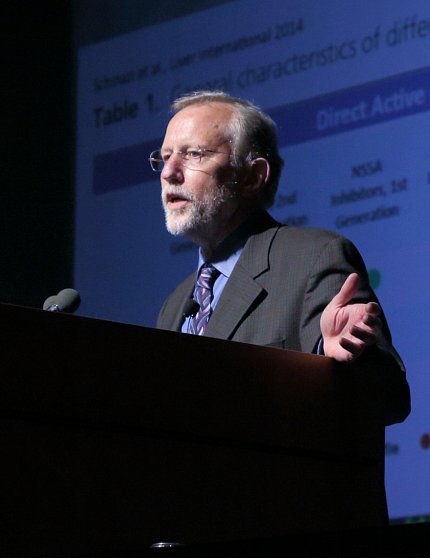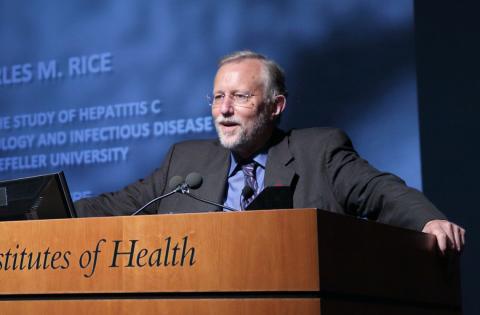Stubborn Challenges Remain with Hepatitis C, Rice Says

Photo: Bill Branson
There is a difference in public health between being remarkably successful and truly effective, and perhaps no virus illustrates that chasm better than hepatitis C.
In the 27 years since NIH’s Dr. Harvey Alter helped identify HCV as the cause of a mysterious form of post-transfusion hepatitis, diagnostics have been created that have made the U.S. blood supply safe from HCV and drugs have been developed that can cure, through elimination of the virus from the body, more than 95 percent of cases.
“That’s quite a trajectory,” said Dr. Charles M. Rice of the Rockefeller University, who gave the George Khoury Lecture June 8 at NIH. But 100 percent eradication of HCV remains a stubborn challenge, he said. Rice believes a vaccine will ultimately be needed to nail that last 5 percent of the problem.
Further complicating the HCV picture is that most cases are undiagnosed. “Only about 10 percent of patients with HCV in the U.S. have been cured,” Rice said. “That’s not a very good track record.” An estimated 170 million people in the world are infected
with HCV.
Also, treatment prices are high (but coming down) and some HCV patients also have liver cancer, cirrhosis and HIV infection. Rice believes, but cannot yet prove, that chronic liver inflammation produced by HCV causes liver cancer.
“A vaccine may be necessary to completely eradicate HCV,” he said. “The vaccine work has lagged behind clinical therapies.”
Even when a vaccine is available, as has been the case since 1982 for hepatitis B, some 240 million people remain chronically infected with HBV, Rice reported; the ethos of “if you build it, they will come” doesn’t necessarily apply to public health challenges.

Photo: Bill Branson
Rice said that although great progress has been made on HCV, “it still has many unanswered questions…and there are excellent experimental systems” for gaining new knowledge.
He reviewed three “what next” scenarios involving: the difficulty of culturing primary HCV isolates; new insights gained from understanding how HCV and other viruses require and manipulate microRNAs; and a new model of immunity and pathogenesis based on an HCV relative found in the Norway rat, which does not enjoy the same sentiment attached to the previous best animal model for HCV studies—the chimpanzee.
Rice remains optimistic about a field where he acknowledges “you never know what’s coming next.” He and colleagues continue analyzing the phenotypes of clinical isolates of HCV and exploring microRNA binding sites that offer hints of a general strategy that viruses employ to infect, replicate and manipulate the host.
He said that next-generation sequencing is revolutionizing virology, allowing scientists to sample the amazing biodiversity of viruses in nature and in particular, the discovery of close relatives of HCV in other animal species, for example horses, bats
and rats.
“There are many related viruses out there in nature,” Rice concluded. He believes animal hepaciviruses will be useful models for understanding HCV immunology and pathogenesis. “They could be useful models for testing HCV vaccine platforms.”
